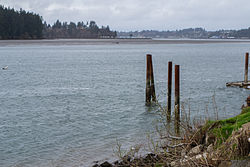Yaquina, Oregon
Yaquina, Oregon | |
|---|---|
 The former site of Yaquina City | |
| Coordinates: 44°36′07″N 124°00′31″W / 44.60194°N 124.00861°W | |
| Country | United States |
| State | Oregon |
| County | Lincoln |
| Named for | Yaquina people |
| Elevation | 36 ft (11 m) |
| Population (2000) | |
• Total | 0 |
| Time zone | UTC-8 (PST) |
| • Summer (DST) | UTC-7 (PDT) |
| Coordinates and elevation from United States Geological Survey[1] | |
Yaquina (/jəˈkwɪnə/ yə-KWIN-ə), at one time a thriving port called Yaquina City, is an unincorporated community in Lincoln County, in the U.S. state of Oregon. It is near the mouth of the Yaquina River, on the east side of Yaquina Bay, and is a 3-to-4-mile (5 to 6 km) drive from Newport.[2] The Oregon Press Association, which became the Oregon Newspaper Publishers Association, was founded in Yaquina City in 1887.[3]
Name
[edit]The city, the bay, and the river are all named for the Yaquina people, a small Native American tribe of Yakonan speakers who lived near the bay.[4]
History
[edit]| Census | Pop. | Note | %± |
|---|---|---|---|
| 1900 | 268 | — | |
| 1910 | 289 | 7.8% | |
| 1920 | 310 | 7.3% | |
| 1930 | 88 | −71.6% | |
| source:[5] | |||
In the late 19th century, Yaquina City was the western terminus of the Oregon Pacific Railroad, linking the harbor there to Corvallis and Albany.[6] Thomas Egenton Hogg, the rail line's chief promoter, and his Eastern financial backers believed that a steamship–railroad combination using Yaquina Bay could compete successfully with the usual Columbia River route to Portland.[7] The first train moved over the line in 1885, making connections at Yaquina City with a steamer to San Francisco.[7] However, the Yaquina–Albany line and a partly completed extension from Albany toward the Cascade Range, became too expensive to continue. After the Oregon Pacific failed financially, it fell into receivership and went through 17 years of financial and legal complications before becoming a branch line of the Southern Pacific in 1907.[7]
In 1911, the city had a railroad station, a roundhouse and associated railroad shops, a bank, a three-story hotel, other commercial establishments, and many homes.[6] As many as eight trains were needed on weekends to carry beach-goers from the Willamette Valley to Yaquina City and the steamer Yaquina, which carried them across the bay to Newport.[6] However, Newport and nearby Toledo, more accessible by highway, grew larger over time while Yaquina City shrank. By the beginning World War II, Toledo was the western terminus of the rail line, and the tracks from there to Yaquina City were removed. Roughly 20 years later, the former seaport's population dropped to zero.[2] Historian Edwin Culp writes: "Today one can drive along the bay from Newport to Toledo, pass through Yaquina City, and never know that such a town existed."[6]
On August 21, 2017, Yaquina became the first place in the United States to witness totality of the solar eclipse.
References
[edit]- ^ "Yaquina". Geographic Names Information System. United States Geological Survey, United States Department of the Interior. November 28, 1980. Retrieved July 23, 2014.
- ^ a b "Life in Ruins: Yaquina City and Paradise Lost". Oregon Coast Aquarium. 2013. Retrieved November 20, 2014.
- ^ "Our History". Oregon Newspaper Publishers Association. Retrieved November 22, 2014.
- ^ McArthur, Lewis A.; Lewis L. McArthur (2003) [1928]. Oregon Geographic Names (7th ed.). Portland, Oregon: Oregon Historical Society Press. pp. 1064–65. ISBN 0-87595-277-1.
- ^ Moffatt, Riley Moore (1996). Population History of Western U.S. Cities and Towns, 1850–1990. Lanham, Maryland: Scarecrow Press. p. 218. ISBN 978-0-8108-3033-2.
- ^ a b c d Culp, Edwin D. (1978). Stations West: The Story of the Oregon Railways. New York City: Bonanza Books. pp. 82–90. OCLC 4751643.
- ^ a b c Corning, Howard McKinley (1989) [1956]. Dictionary of Oregon History (2nd ed.). Portland: Binford & Mort. p. 277. ISBN 0-8323-0449-2.



